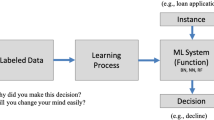Abstract
This paper deals with the problem of identifying a hidden Boolean function ℱ: 0, 1' → 0, 1 from positive and negative examples. This problem is of paramount importance in many real life applications of artificial intelligence. The method proposed in this paper is based on a branch-and-bound approach. This approach is an expansion of some earlier work (Triantaphyllouet al., 1994). Computational results, comparing the new method with one based on Karmakar's interior point method, suggest that the new method is very efficient.
Similar content being viewed by others
References
Angluin, D. and C. H. Smith (1983), Inductive Inference: Theory and Methods,Computing Surveys 15, 237–265.
Bongard, M. (1970),Pattern Recognition, Spartan Books, New York, NY.
Brayton, R. K., G. D. Hachtel, C. T. McMullen, and A. L. Sangiovanni-Vincentelli (1985),Logic Minimization Algorithms for VLSI Minimization, Kluwer Academic Publishers, Dordrecht.
Blair, C. E., R. G. Jersolow, and J. K. Lowe (1985), Some Results and Experiments in Programming Techniques for Propositional Logic,Computers and Operations Research 13, 633–645.
Carbonell, J. G., R. S. Michalski, and T. M. Mitchell (1983), An Overview of Machine Learning from Examples, R. S. Michalski, J. G. Carbonell, and T. M. Mitchell (eds.),Machine Learning: An Artificial Intelligence Approach, Tioga Publishing Company, Palo Alto, CA, 3–23.
Carraghan, R. and P. M. Pardalos (1990), An Exact Algorithm for the Maximum Clique Problem,Operations Research Letters 9(11), 375–382.
Cavalier, T. M., P. M. Pardalos, and A. L. Soyster (1990), Modeling and Integer Programming Techniques Applied to Propositional Calculus, J. P. Ignizio (ed.),Computers and Operations Research 17(6), 561–570.
Dietterich, T. C. and R. S. Michalski (1983), A Comparative Review of Selected Methods for Learning from Examples, R. S. Michalski, J. G. Carbonell, and T. M. Mitchell (eds.),Machine Learning: An Artificial Intelligence Approach, Tioga Publishing Company, Palo Alto, CA, 41–81.
Gimel, J. F. (1965), A Method of Producing a Boolen Function Having an Arbitrarily Prescribed Prime Implicant Table,IEEE Trans. Computers 14, 485–488.
Hooker, J. N. (1988a), Generalized Resolution and Cutting Planes, R. G. Jeroslow (ed.),Annals of Operations Research 12(1–4), 217–239.
Hooker, J. N. (1988b), A Quantitative Approach to Logical Inference,Decision Support Systems, North-Holland, 4, 45–69.
Jeroslow, R. G. (1988), Computation-Oriented Reductions of Predicate to Prepositional Logic,Decision Support Systems, North-Holland, 4, 183–197.
Jeroslow, R. G. (1989),Logic-Based Decision Support, North-Holland, Amsterdam.
Kamath, A. P., N. K. Karmakar, K. G. Ramakrishnan, and M. G. C. Resende (1990), Computational Experience with an Interior Point Algorithm on the Satisfiability Problem,Annals of Operations Research, P. M. Pardalos and J. B. Rosen (eds.), Special issue on: Computational Methods in Global Optimization,25, 43–58.
Kamath, A. P., N. K. Karmakar, K. G. Ramakrishnan, and M. G. C. Resende (1992), A Continuous Approach to Inductive Inference,Math. Programming 57(2), 215–238.
Karmakar, N. K., M. G. C. Resende, and K. G. Ramakrishnan (1991), An Interior Point Algorithm to Solve Computationally Difficult Set Covering Problems,Math. Programming 52(3), 597–618.
Kearns, M., Ming Li, L. Pitt, and L. G. Valiant (1987), On the Learnability of Boolean Formulae,Journal of the Association for Computing Machinery 34(9), 285–295.
Peysakh, J. (1987), A Fast Algorithm to Convert Boolean Expressions into CNF,IBM Computer Science RC 12913 (#57971), Watson, NY.
Pitt, L. and L. G. Valiant (1988), Computational Limitations on Learning from Examples,Journal of the Association for Computing Machinery 35(4), 965–984.
Quinlan, J. R. (1979), Discovering Rules by Induction from Large Numbers of Examples: A Case Study, D. Michie (ed.),Expert Systems in the Micro-Electronic Age, Edinburgh University Press.
Quinlan, J. R. (1983), Learning Efficient Classification Procedures and Their Application to Chess and Games, R. S. Michalski, J. G. Carbonell, and T. M. Mitchell (eds.),Machine Learning: An Artificial Intelligence Approach, Tioga Publishing Company, Palo Alto, CA, 3–23.
Quinlan, J. R. (1986), Induction of Decision Trees,Machine Learning 1(1), 81–106.
Triantaphyllou, E., A. L. Soyster and S. R. T. Kumara (1994), Generating Logical Expressions from Positive and Negative Examples via a Branch-and-Bound Approach,Computers and Operations Research 21(2), 185–197.
Triantaphyllou, E. and A. L. Soyster (1994a), A Relationship between CNF and DNF Systems Derivable from Examples,ORSA Journal on Computing, to appear.
Triantaphyllou, E. and A. L. Soyster (1994b), On the Minimum Number of Logical Clauses which Can be Inferred from Examples,Working Paper, Department of Industrial and Manufacturing Systems Engineering, Louisiana State University, Baton Rouge, LA 70803-6409, U.S.A.
Triantaphyllou, E. and A. L. Soyster, (1994c), An Approach to Guided Learning of Boolean Functions From Examples,Working Paper, Department of Industrial and Manufacturing Systems Engineering, Louisana State University, Baton Rouge, LA 70803-6409, U.S.A.
Valiant, L. G. (1984), A Theory of the Learnable,Comm. of ACM 27(11), 1134–1142.
Valiant, L. G. (1985), Learning Disjunctions of Conjunctives,Proceedings of the 9th IJCAI, 560–566.
Williams, H. P. (1986), Linear and Integer Programming Applied to Artificial Intelligence,Preprint series, University of Southampton, Faculty of Mathematical Studies, 1–33.
Williams, H. P. (1987), Linear and Integer Programming Applied to the Propositional Calculus,International Journal of Systems Research and Information Science 2, 81–100.
Author information
Authors and Affiliations
Rights and permissions
About this article
Cite this article
Triantaphyllou, E. Inference of a minimum size boolean function from examples by using a new efficient branch-and-bound approach. J Glob Optim 5, 69–94 (1994). https://doi.org/10.1007/BF01097004
Received:
Accepted:
Issue Date:
DOI: https://doi.org/10.1007/BF01097004




